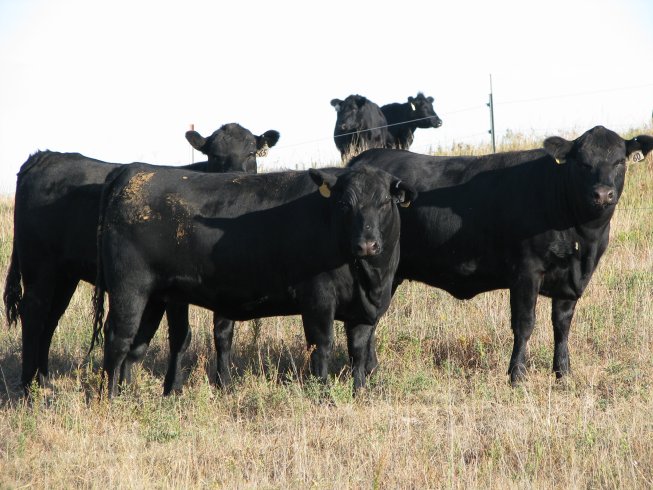
By Dennis Bauer, UNL Extension Educator
Mineral supplementation for beef cows has been a topic of conversation for many years. In most grazing and forage fed cattle, phosphorus is the only major mineral that should be of concern. Most forages are relatively high in calcium and potassium and usually do not need to be supplemented.
Phosphorus requirements for the beef animal were lowered slightly in the 2000 NRC (National Research Council) publication. This was a surprise by some, however, a review of Utah research found that phosphorus levels had to drop to 0.09% (approximately half of current published requirements) before major deficiencies were noted. Additional research by Judkins et al. in New Mexico reported that phosphorus supplementation was only beneficial in one of five years and that year was a severe drought year. The 2000 NRC publication shows phosphorus requirements to be the highest for the beef cow 60 days after calving (0.22% phosphorus) going to approximately 0.12% after weaning her calf. Many forages will exceed this level of phosphorus in the growing period when the forage is green. After the forage is dormant it is likely that the level of phosphorus will drop down to 0.10% - 0.12%, hence some supplementation may be needed. This suggests that perhaps no phosphorus supplementation is needed in the spring and mid-summer.
The levels of phosphorus in many of the harvested forages such as oat, alfalfa, millet, forage sorghum and sudan cross hybrids will contain levels of 0.15% and higher, thus making phosphorus supplementation a low priority when these forages are fed.
Most of the protein supplements contain high concentrations of phosphorus such as 0.85% in corn gluten feed, 0.64% in cottonseed cake, 0.80% in distillers grain with solubles, 1.03% in sunflower meal, 1.02% in wheat middlings, and 0.65% in soybean meal. These protein sources, when fed at 1 to 2 pounds per head per day supply a substantial amount of phosphorus in the cow’s diet.
Trace Minerals
The recommendation of trace mineral supplementation is troubling both from a proper level and source standpoint. Again, forage analysis provides some guidance on the level of supplementation needed. Some questions are asked if clipped samples of standing forages are adequate to accurately determine the level of trace minerals in the forage consumed by the cow. Although it may not perfectly predict the composition of what the cow is consuming, it is probably accurate enough to utilize as meaningful information in designing a trace mineral supplement program. Data where forages were analyzed for trace minerals, found that often times zinc and copper levels are low in grasses in the high plains region. Personal data and observations often find that grass forages in central and western Nebraska will contain approximately 12-20 parts per million (ppm) of zinc and often copper will be in the range of 4-8 ppm. Requirements for zinc in the 2000 NRC are 30 ppm showing that grass forages may only supply half of the needed zinc. Copper requirements are set at 10 ppm in the 2000 NRC if no antagonizing minerals, such as molybdenum, iron sulfate, nitrates plus possibly other trace minerals that are present at relatively high levels. It is known that these minerals plus nitrates may interfere with the absorption of copper by forming complexes primarily in the rumen and in some cases compete with copper in catalyzing some metabolic reactions. The 2000 NRC states that if molybdenum is greater than 2 ppm (5:1 ration) and sulfur is greater than 0.25% then the copper requirement is greater than 10 ppm.
Results from a 3 year study conducted in 11 counties in North Central Nebraska totaling over 1,000 forage samples, including meadow, oat, millet, forage sorghum, alfalfa, alfalfa/grass mix, and sorghum/sudan cross hay found that the levels of Calcium, Magnesium, Manganese, Potassium, and Sulfur were in concentrations high enough to meet a cow’s requirements 90% to 100% of the time when fed as the main ration ingredient.
Strategies to fine tune mineral programs for beef cows that maintain production levels and reduce cost include:
1. Test feeds for mineral content.
2. Remember to give credit for mineral content of any protein or energy supplement being fed.
3. Balance ration for minerals to determine need for supplementation.
4. Have a custom mineral mix made based on your herd’s need or purchase a commercial mineral mix that comes closest to what your custom mix would be.
5. Do not allow over consumption.
The bottom line is mineral supplementation is not a magic bullet. It will not replace nor is a substitute for proper energy and protein intake to maintain cows in good body condition (score 5) on a 9 point scale. http://beef.unl.edu/web/beef/learning/condition1b.shtml
The cost in most cases to balance the cow herd’s mineral supplementation needs in Nebraska and surrounding states can be as low as $12 to $15 per head per year when giving credit for the minerals supplied in all of the feed supplied to the animal either by grazing and or feeding.
For more information you can view a webinar entitled Vitamins and Minerals for Beef Cows
http://beef.unl.edu/web/beef/vitaminsandminerals
Minerals and Vitamins for Beef Cows EC288
http://www.ianrpubs.unl.edu/epublic/live/ec288/build/ec288.pdf
Calculating Trace Minerals for Beef Cows
http://beef.unl.edu/learning/needscalculator.shtml
For more UNL Beef information go to http://beef.unl.edu